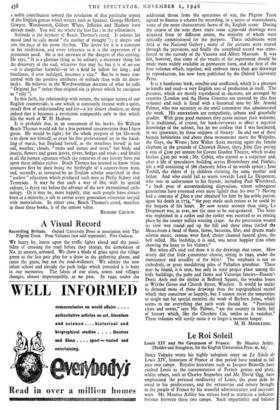A Visual Record
Recording Britain. Oxford University Press in association with The Pilgrim Trust. Four Volumes (not sold separately). Five Guineas.
WE hurry by, intent upon the traffic lights ahead and the possi- bility of crossing the road before they change, the demolition of No. 32 unseen, unheard. We chew a blade of grass upon the village green as the last pair play for a draw in the gathering gloom, and curse the gnats, but not the road-wideners. We admire the new infant school and already the park lodge which preceded it is hazy in our memories. The fabric of our cities, towns and villages changes, almost. imperceptibly, as we pass. In 1940, under the additional threat from the operations of war, the Pilgrim Trust agreed to finance a scheme for recording, in a series of watercolours, some of the more characteristic facets of the English scene. During the course of the next three years some 1,50o-odd drawings were acquired from 97 different artists, the majority of whom were specially commissioned for the purpose. Three exhibitions were held at the National Gallery ; many of the pictures were toured through the provinces, and finally the completed record was trans- ferred to the custody of the Victoria and Albert Museum. It was felt, however, that some of the results of the experiment should be made more widely available in permanent form, and the first of the four volumes which, together, will embrace more than 400 drawings in reproduction, has now been published by the Oxford University Press.
It is a handsome book, sensible and unaffected, which is a pleasure to handle and read—a very English sort of production in itself. The pictures, which are mostly reproduced in duotone, are arranged by counties (London and the Home Counties are covered by this first volume) and each is faced with a historical note by Mr. Arnold Palmer, who was secretary to the small committee that administered the work. His annotations are sympathetic, urbane and gracefully erudite. With great good manners they never outstay their welcome. It is traditional, of course, for book-reviewers to affect a superior knowledge of the subject, but let me confess that I was fascinated, in my ignorance, by these snippets of history. In and out of these human habitations and about these monuments move the Walpoles, the Gays, the Wrens ; here Walter Scott meeting again the female elephant in the grounds of Chiswick House, there John Gay paying a rent of £roo per annum for Covent Garden Theatre, which to-day fetches £500 per week ; Mr. Cubitt, who started as a carpenter and, after a life of speculative building across Bloomsbury and Pimlico, left a will consisting of 386 chancery folios of 90 words apiece ; Joan Tothill, the eldest of 33 children claiming the same mother and father. And who could fail to warm towards Lord Le Despencer, who was so unfortunate in his friends, including Paul Whitehead, " a hack poet of accommodating disposition, whom subsequent generations have esteemed even more lightly than his own "? Having had a sinecure of £800 a year obtained for him by his noble patron, upon his death in 1774, " the poet made such return as he could by the bequest of his heart. By now nearer seventy than sixty, Le Despencer was, as ever, not the man to be out-gestured. The heart was enshrined in a casket and the casket was escorted to its resting place by the county militia wearing crape. As the procession wound its slow way round and up the hill and three times circled the Mausoleum a band of flutes, horns, bassoons, fifes, and drums made solemn music, cannon were fired, choirs chanted funeral glees, the bell tolled. His lordship, it is said, was never happier than when showing the heart to his visitors."
But when all's said and done it is the drawings that count. How wisely did that little committee choose, sitting in 1940, under the imminence and actuality of the blitz! The emphasis is not on cathedrals, or great mouldering piles of Palladian grandeur. These may be found, it is true, but only in their proper place among the little buildings, the pubs and farms and Victorian fancies—Euston's Doric Arch and the shelter in Bedford Square, the wooden house at Wrythe Green and Church Street, Windsor. It would be unfair to demand more of these drawings than the topographical record which they constitute so happily, but I cannot resist the temptation to single out for special mention the work of Barbara Jones, which seems to me everything that such work should be. "Provincial cities and towns," says Mr. Palmer, " are the country in little, full of history which, like the Cheshire Cat, smiles as it vanishes." These volumes will surely cause it to linger a moment longer.
M. H. MIDDLETON.


































 Previous page
Previous page